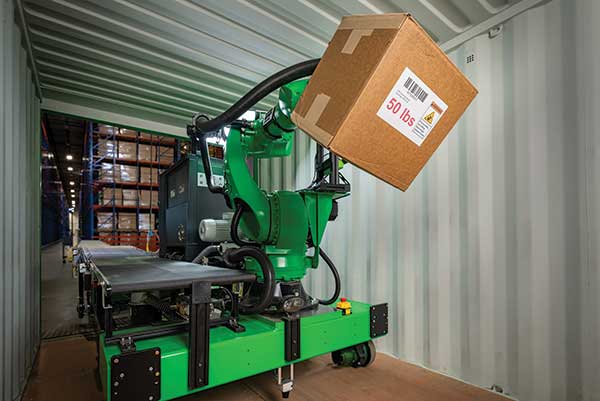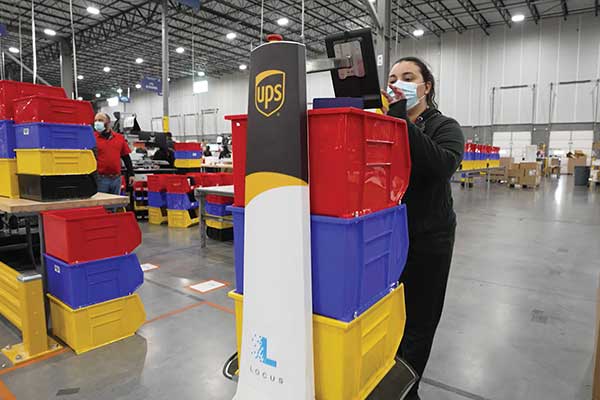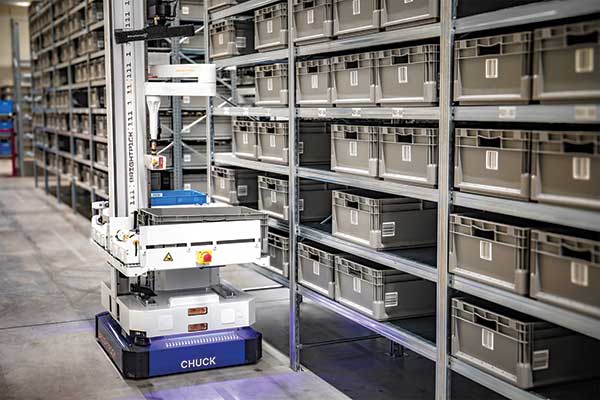Up close and personal with mind twisting special purpose robots
Clearly, the sky is the limit for this class of autonomous robots. Here are what four of the leaders can already do with about as little human intervention as you can imagine.
In talking to experts for this article, it became evident that simply saying “special purpose robots” can be a tongue twister.
At the same time, it also became evident that the capabilities of this class of autonomous mobile robots is a mind twister, too.
(By the way, I’m sure you have by now tested yourself on your verbal dexterity saying—special purpose robots. No one escapes without trying at least once.)
“People in supply chain know that autonomous robots are not just the future. They are also what will make the future different,” says Pete Blair, vice president of marketing and sales at Pickle Robot.
And even though that comment is from within the supplier community, it’s tough to argue with. There’s just an inevitability about autonomous mobile robots in a very wide range of uses.
These forms of mobile automation are a bundle of tightly integrated capabilities, says Mike Fair, director of product management, Warehouse Robotics at Boston Dynamics.. He says the story of robots is all about mobility, manipulation and autonomy.
As if that’s not enough, Fair projects that robots will be repurposed. Potentially not just on current activities, but in future generations of the technology.
Along those lines, “as robots continue to advance, we need to think about operations holistically or we will simply be automating isolated problems that we thought we were solving,” says Kait Peterson, senior director of product marketing at Locus.
Jan Zizka, CEO of Brightpick, looks at the future this way: “Robots epitomize the technological transformation of supply chains from manual, labor-intensive operations to neatly orchestrated, automated work flows. By standardizing processes and minimizing human error and variability, robots pave the way for the creation of a digital twin of the warehouse. It’s the digitalization of the warehouse. In essence, robotization becomes the catalyst for the warehouse’s holistic transformation into the digital realm.”
Enough of looking out to the future. Here are four scenarios for special purpose robots in the here and now.
Up Close and Personal with Pickle Robot
Some people have a presence that arrives in a room before they are physically there. Pickle robot does much the same in over-the-road trailers with its distinctive bright green color.
The industrial robot arm is mounted on a base with brains on board, explains Pete Blair, Pickle’s vice president of marketing and sales. It moves into a trailer autonomously, using on-board decision-making capabilities that include artificial intelligence (AI).
Blair says the robot is capable of unloading floor-loaded trailers as needed. “It makes 400 to 1,500 box movements an hour. Typically, Pickle can load or unload a trailer in about two hours,” he adds.
When unloading a trailer, cameras mounted on the arm download images of the wall of boxes in front of it, dynamically initiating picking decisions. Blair explains that “best fit” algorithms make a decision on which box and how to grab it before manipulating it in 4 to 8 seconds.
Picked boxes are moved by the arm to a takeaway conveyor for movement to the next receiving step. Then the arm returns to a picking position and the cameras initiate the picking sequence all over again.
Typically, a robot services up to three dock doors, minimizing the distance it moves between trailers.
The secret to Pickle’s success, says Blair, is physical AI. “Physical AI is software-enabled hardware [intelligent robotics] built on generative AI, machine vision and autonomous capabilities. Pickle takes a synchronized approach to hardware and software development built on generative AI and machine vision to build a proprietary autonomy stack,” Blair explains.
Up Close and Personal with Locus Robotics
For some people, 10,000 steps a day is desirable. At UPS Healthcare in Louisville, Ky., order pickers weren’t interested in walking 10,000 steps a day.
So, the facility turned to 24 autonomous mobile robots (AMRs) to speed picking orders every day.
What they got was a 54% increase in lines picked as well as improved order accuracy, workplace ergonomics and employee morale. “I would say UPS was proactive in the health, safety and retention of their workers as they reduced the physical demands of the typical warehouse job,” says Kait Peterson, senior director of product marketing at Locus Robotics.
Each AMR consists of an autonomous base with a vertical order shelf mounted above it. When an AMR arrives in a pick zone, the human order picker follows the instructions on the AMRs tablet, placing items in designated locations on the shelf. AMRs are released by a touch of the tablet to travel to their next picking location.
The AMRs are connected to a warehouse execution platform that makes both the routing and picking decisions for each bot. A suite of dashboards and actionable reporting tools provide real time updates on the warehouse floor.
For traceability, each bot captures the associate’s information and what was picked directly to the warehouse management system (WMS). This data meets compliance requirements and ensures an historical record of picking and order fulfillment activities. As a result, UPS Healthcare has much improved data insights to its operations.
“One of the reasons we were looking at an AMR solution was to allow our employees to focus on value-added tasks instead of walking the warehouse while pushing carts,” says Mike Packer, director of Healthcare Automation and Implementations at the UPS facility.
He continues to say that the AMRs had to maximize order accuracy and productivity while ensuring healthcare standards compliance. And they do.
Up Close and Personal with Brightpick
Pull. Pick. Push.
That’s how Jan Zizka summarizes the essence of mobile robots from Brightpick, where he is CEO and co-founder.
“Brightpick’s Autopicker is the world’s only autonomous mobile robot able to pick and consolidate items in warehouse aisles,” Zizka explains.
These autonomous mobile robots pick orders and replenish pharmaceutical inventory at Dr. Max, Europe’s second largest pharmacy chain with 3,000 pharmacies across six European countries.
Eight Autopicker robots handle 7,500 items daily at Dr. Max’s Prague pharmaceutical DC. The bots have access to 2,500 SKUs in the DC.
The autonomous bots travel from aisle to aisle of shelving filled with totes of pharmaceuticals and related inventory. Fleet management software, essentially a pared down warehouse execution system, helps coordinate the overall flow of the bots. That software is connected to a WMS and an enterprise resource planning (ERP) system that manage orders.
On-board intelligence including AI directs each bot to a desired floor location. There, the bot stops, retrieves a tote from storage and picks items from the storage tote into the order tote it’s carrying. The process is complete when the bot returns the storage tote back to its location on the shelf.
And the bot is on to its next destination.
“These bots automate 100% of the walking and 80% of the picking previously done by human pickers. In a typical e-commerce warehouse, just 20% of the items requested require human intervention to complete the pick with goods-to-person picking,” says Zizka.
Clearly, many different components make pull/pick/push work. “This is a full commercial order picking and stock replenishment solution,” says Zizka. “It’s much more than a mobile robot that does picking.”
Up Close and Personal with Boston Dynamics
To say to Mike Fair, “well, that’s a stretch,” you’re not doubting his honesty.
Instead, you’re calling Boston Dynamics’ first commercial robot specifically designed for warehouses by name. Yep. It’s called Stretch.
“Stretch is our versatile, autonomous mobile robot for more efficient, safer warehouse operations,” says Fair, director of product management, Warehouse Robotics at Boston Dynamics. “Stretch unloads floor-loaded trailers and shipping containers,” he adds.
Able to handle up to 800 cases an hour weighing up to 50 pounds each, the robot is on the job at DHL, Maersk, Gap, H&M and NFI. Locations are in the U.S. and Europe.
He says Stretch is different because it can unload boxes in trailers dynamically with no prior information as to box configuration or trailer surroundings. Picked boxes are placed on a takeaway conveyor also in the trailer.
The robot can pick up to four boxes at a time, also with no prior information. All handling decisions are made in real time. Fair says the robot runs continuously for 16 hours using lithium-ion batteries.
Handling decisions are made onboard using data from vision sensors mounted on the robot. If a box falls to the trailer floor, the vision sensors redirect the robotic arm to pick up and retrieve it. No human intervention is required, says Fair.
The robot’s footprint is the size of a pallet. It can move autonomously in any direction both within the trailer and between trailers at different docks.
Fair says it takes five days or fewer to implement Stretch at a warehouse, and it can work with existing docks and trailers.

Article Topics
Boston Dynamics News & Resources
Up close and personal with mind twisting special purpose robots Retailer Otto Group teams with Boston Dynamics on warehouse robotics deployments Robotic picking market worth $6.8 billion by 2030, up from $236 million last year DHL Supply Chain achieves first commercial deployment of Boston Dynamics’ Stretch robot NFI to deploy Boston Dynamics’ Stretch robot in a $10 million deal Boston Dynamics’ Stretch robot now available for commercial purchase DHL Supply Chain to invest $15 million to further automate DCs via Boston Dynamics collaboration More Boston DynamicsLatest in Materials Handling
Geek+ and System Teknik deploy PopPick solution for pharmacy group Med24.dk Beckhoff USA opens new office in Austin, Texas Manhattan Associates selects TeamViewer as partner for warehouse vision picking ASME Foundation wins grant for technical workforce development The (Not So) Secret Weapons: How Key Cabinets and Asset Management Lockers Are Changing Supply Chain Operations MODEX C-Suite Interview with Harold Vanasse: The perfect blend of automation and sustainability Consultant and industry leader John M. Hill passes on at age 86 More Materials HandlingAbout the Author
Subscribe to Materials Handling Magazine

Find out what the world's most innovative companies are doing to improve productivity in their plants and distribution centers.
Start your FREE subscription today.
April 2024 Modern Materials Handling

Latest Resources















